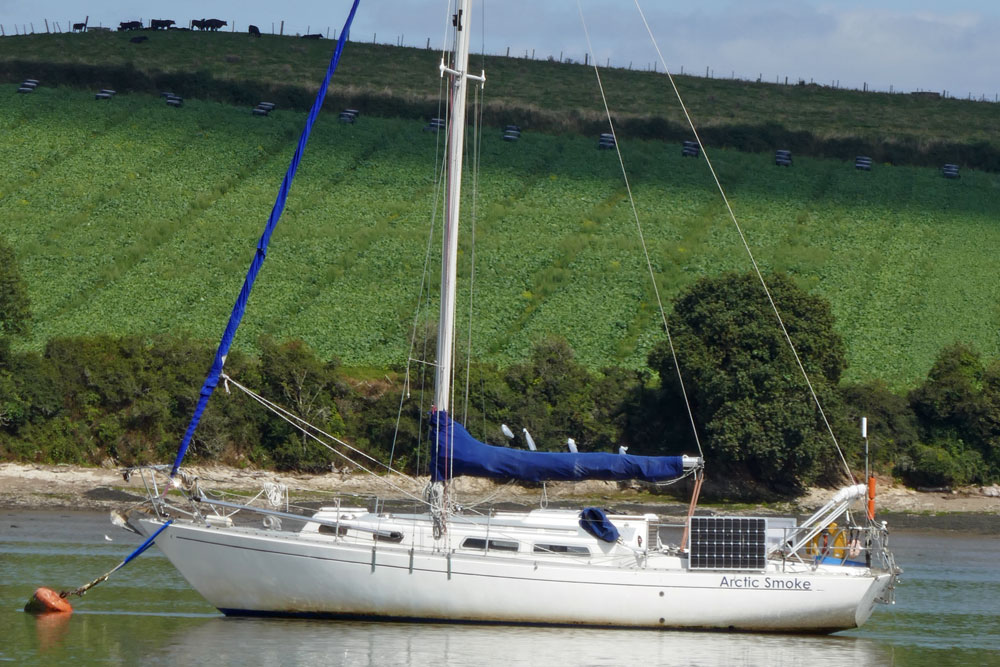- Home
- Cruising Yachts 30' to 35'
- Elizabethan 33
The Elizabethan 33 Sailboat
Specs & Key Performance Indicators
The Elizabethan 33, a long-keeled heavy displacement sloop, was designed by David Thomas and built in the UK by Peter Webster Ltd.
 Elizabethan 33
Elizabethan 33Published Specification for the Elizabethan 33
Underwater Profile: Long keel
Hull Material: GRP (Fibreglass)
Length Overall: 33'0" (10.1m)
Waterline Length: 25'0" (7.6m)
Beam: 9'4" (2.8m)
Draft: 4'7" (1.4m)
Rig Type: Masthead sloop*
Displacement: 12,320lb (5,588kg)
Designer: David Thomas
Builder: Peter Webster Ltd (UK)
Year First Built: 1973
* Also available as a ketch
Published Design Ratios for the Elizabethan 33
1. Sail Area/Displacement Ratio: Not published
2. Ballast/Displacement Ratio: 42.4
3. Displacement/Length Ratio: 352
4. Comfort Ratio: 35.5
5. Capsize Screening Formula: 1.6
Summary Analysis of the Design Ratios for the Elizabethan 33
1. In the absence of any Sail Area/Displacement Ratio we are unable to make an assessment of this element of the Elizabethan 33's performance.
2. A Ballast/Displacement Ratio of 42.4 means that the Elizabethan 33 will stand up well to her canvas in a blow, helping her to power through the waves.
3. A Displacement/Length Ratio of 352, tells us the Elizabethan 33 creeps into the ultra-heavy displacement category. Load her up as much as you like and her performance will be hardly affected, not that it was ever startling. Few if any sailboats are built to this displacement category these days - but they remain popular with some long-distance sailors.
4. Ted Brewer's Comfort Ratio of 35.5 suggests that crew comfort of an Elizabethan 33 in a seaway is similar to what you would associate with the motion of a moderate bluewater cruising boat - a predictable and acceptable motion for most seasoned sailors.
5. The Capsize Screening Formula (CSF) of 1.6 indicates that an Elizabethan 33 would be a safer choice of sailboat for an ocean passage than one with a CSF of more than 2.0.
More about the Elizabethan 33 Sailboat...
The Elizabethan 33 has a traditional look with a low freeboard, a long overhang at the bow, and a canoe stern. The cockpit is spacious and well-protected by high coamings. The deck layout is simple and functional, with wide side decks, sturdy stanchions, and ample handrails.
The Elizabethan 33 is a seaworthy and stable boat that can handle rough weather and long passages. It has a good reputation for being well-built, strong, and reliable. Like most long keel boats it's not very fast or agile, but it can sail well upwind. It is also comfortable and spacious for its size, offering enough room for up to six people.
Accommodation
The Elizabethan 33 has a traditional layout with two separate cabins: a forecabin with a V-berth and storage lockers, and an aft cabin with a quarter berth on the starboard side and a navigation station on the port side. The saloon has two settees that can be converted into berths, one of which can be raised to form a double berth. The saloon also has a folding table that drops to berth level, a smooth moulded GRP headlining, and teak and holly floorboards.
The galley is located on the port side of the companionway and has a two-burner stove with oven, a sink with manual water pump, and plenty of storage space. The head is opposite the galley on the starboard side and has a marine toilet, a washbasin, and a hanging locker. The boat has plenty of natural light and ventilation from several portholes, hatches, and dorade vents.
The accommodation is cozy and practical, with good headroom (6 feet) throughout the boat. The berths are all 6 feet 3 inches long, except for the quarter berth which is shorter (5 feet 3 inches) and more suitable for children. The boat has ample storage space for cruising gear and provisions, as well as some nice touches such as brass lamps, curtains, cushions, and woodwork.
Hull and Deck
The hull of the Elizabethan 33 is made of solid GRP using woven rovings, which makes it very strong and durable. The hull is also well-insulated from heat and noise by foam or cork sheets between the inner moulding and the outer skin. The hull shape is round-bilged with a fine entry at the bow and a full run aft. The hull has no chines or hard spots that could cause slamming or pounding in rough seas.
The deck of the Elizabethan 33 is also made of GRP with balsa or plywood cores in horizontal areas, replaced by solid GRP in stress areas for fitting hardware. The deck has an anti-slip surface that provides good grip and traction. The deck fittings are mostly stainless steel or bronze, such as cleats, winches, fairleads, chainplates, etc. The deck hardware is well-placed and easy to access.
The cockpit is spacious and well-protected by high coamings. It has a tiller steering, a compass, and a sprayhood. The cockpit also has a locker for storage and access to the engine. The cockpit is comfortable and functional for sailing and relaxing.
This article was written with the assistance of Gemini, a large language model developed by Google. Gemini was used to gather information, summarize research findings, and provide suggestions for the content and structure of the article.
Recent Articles
-
Is An SSB Marine Radio Installation Worth Having on Your Sailboat?
Apr 14, 25 02:31 PM
SSB marine radio is expensive to buy and install, but remains the bluewater sailors' favourite means of long-range communication, and here's why -
Correct VHF Radio Procedure: Your Questions Answered
Apr 14, 25 08:37 AM
Got a question about correct VHF radio procedure? Odds are you'll find your answer here... -
VHF Marine Radio; Which One is Right for Your Boat?
Apr 14, 25 05:09 AM
If you're looking to buy a VHF Marine Radio the choice can be a bit overwhelming. So what should it be, a fixed VHF or a handheld VHF? Maybe one with AIS or GPS built in perhaps?













